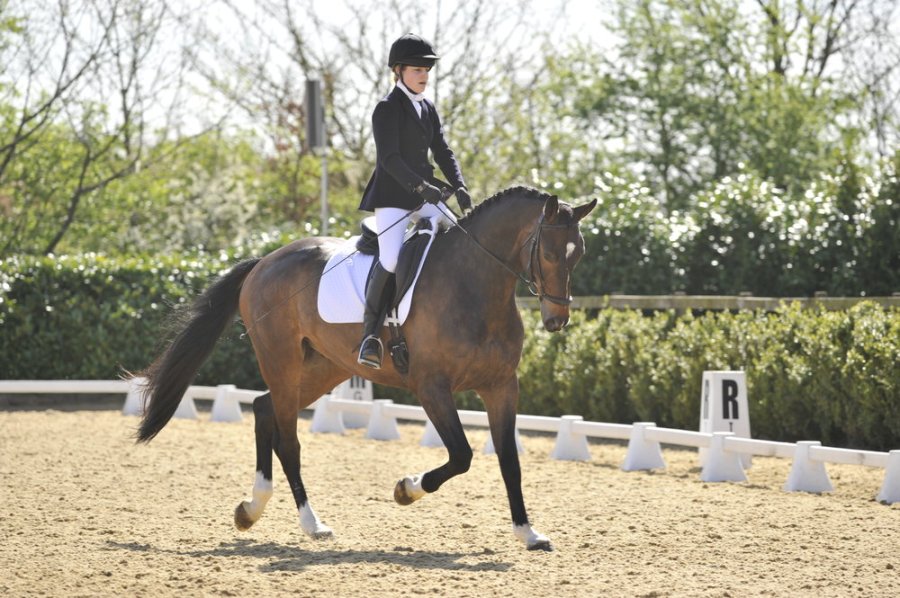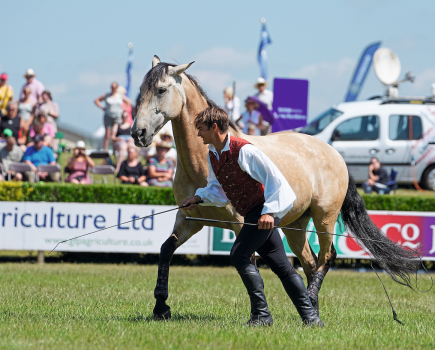A horse who is equally balanced, strong and comfortable when you are riding on either diagonal in trot is important for every horse and rider, whether you ride competitively or love hacking a horse. Understanding what the diagonals are, identifying whether you are on the correct one and knowing how to change it, will make for a smoother ride on a more balanced horse — it even plays an important role in helping to keep a horse sound.
The diagonals are all about timing: the moment you rise out of the saddle according to what your horse’s legs are doing beneath you. To understand this, you first need to appreciate the mechanics of the trot. Trot is a two-beat gait in which the legs move in diagonal pairs; the right front leg and left hind leg move together, as do the left front leg and the right hind leg.
“A good tip to help you become familiar with the sequence of legs in trot is to use different colour bandages on the two diagonal pairs of legs. You can then watch the horse and clearly see which legs are working together,” says UKCC Level Four trainer Sam York, who is an MSc in professional sports coaching and BHS lead assessor.
Being on the correct diagonal means sitting in the saddle when the outside front and inside hind legs move back and rising when they move forward.
Benefits of being on the correct diagonal for your horse
Riding on the correct diagonal when schooling and regularly changing your diagonal when hacking is important because:
- It ensures the horse’s hind legs take an equal workload.
- It promotes suppleness through the horse’s back.
- It allows their muscles to develop evenly.
- It helps to keep your horse balanced when riding around corners.
- All of the above is especially key when training young or inexperienced horses.
- It’s easier for the horse’s inside hind leg to step through if the rider’s out of the saddle and he will be able to take a longer stride. Remember, that the hind legs create the energy and impulsion.
- The previous point is particularly important when riding a circle or turn as if the rider is sat in the saddle when the inside hind leg comes through it places additional strain
Benefits for being on the correct diagonal for riders
“Being able to feel the sequence of the horse’s legs underneath you helps to advance the movement and is important for further training and to set up for long-term equitation,” explains Sam. “Being able to feel and understand the diagonals in trot leads to recognising the correct leg in canter, knowing when to apply the aids and the timing of asking for canter. If you can’t feel the diagonal you won’t be able to feel for canter.”
How to recognise you’re on the correct diagonal
- In walk, shut your eyes while on the lunge and learn to feel when the horse’s inside hind leg steps under. If you find it difficult, have a friend on the ground who shouts: ‘Inside hind leg steps under… now… now… now’ every time that leg comes underneath you, so you can start to identify what that movement feels like.
- In trot, the phrase: ‘Rise and fall with the leg towards the wall’ can help you to remember that it’s the horse’s outside legs you need to be concentrating on. You should be sitting when the outside front leg comes back and rising when it moves forward. A brief look down to see where the horse’s outside shoulder is can help — but look with your eyes only, don’t tip your head, as your chance in weight will unbalance your horse.
- Recognising whether you’re on the correct diagonal can be simpler when on a circle as more weight is transferred to the horse’s inside leg and therefore it can be easier to feel. Ride a small circle of 10m or 15m and see if it helps you to feel the sequence of legs and when you should be rising and sitting.
How to change your diagonal
If you need to change your diagonal, sit in the saddle for two beats before rising again. In an arena, this is usually done when you cross the centre line to change the rein. Out hacking it can be done anywhere. “Practise sitting lightly and softly in the saddle for the double beat; you want to perfect the art of changing the diagonal without the horse noticing,” advises Sam, , who is a Fellow of the BHS.
What if you’re on the wrong diagonal?
“Some horses are very sensitive and will know if you’re not on the right diagonal, while others will carry on oblivious,” says Sam. “Some horses who are stiff, crooked or have muscle imbalances tend to throw you off onto the wrong diagonal, and often riders have a favourite diagonal too.”
A horse who favours a diagonal or whose rider doesn’t regularly change the diagonal will often feel uncomfortable when ridden on the little-used diagonal, making it easy to identify. It may feel harder to rise. Persevere and start doing it now — you’ll soon feel a difference.
Exercises to practice the diagonals
- Ride a three-loop serpentine in your training field or arena, changing your diagonal every time you cross the centre line. Ensure you’re on the correct diagonal ahead of the next turn.
- Make sure you systematically change the diagonal you’re on while hacking too.
- Practise transitioning from walk to trot and notice if you always pick up the same diagonal. If you are, remember to change it regularly!
Challenge yourself to be on the correct all the time
When you become aware of the diagonals, you’ll find that you go into auto-pilot mode and will naturally pick up the correct one as your horse begins to trot. It’s a good habit to have out hacking too. I do a lot of trot work out hacking and I regularly change the diagonal, usually at each bend in the path or road, so that I’m on the correct diagonal.
When I ride a different horse, I can instantly tell when their regular rider isn’t aware of the diagonals, because the horse is really uncomfortable to rise to on one side. Sometimes I find horses are so uneven, that it’s possible to see it while watching on the ground. If your horse feels like this, don’t give up. Continue to change on to the harder diagonal little and often, and you’ll soon see an improvement.










